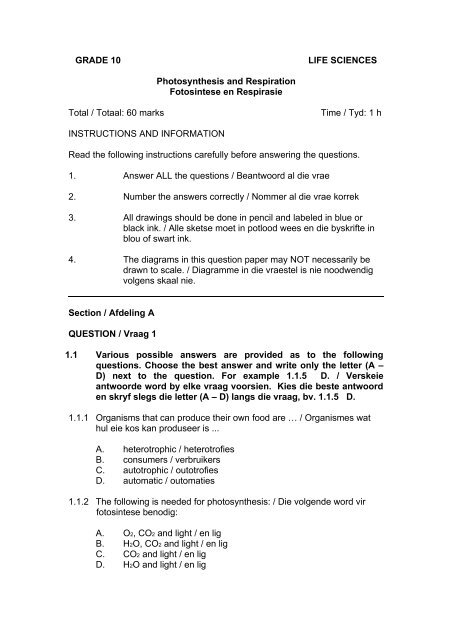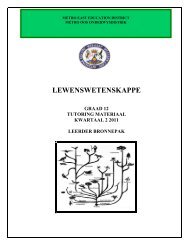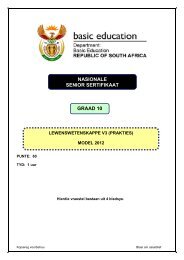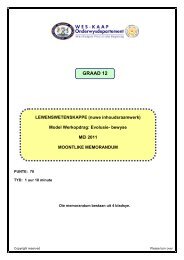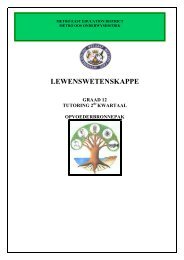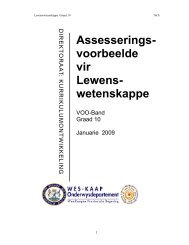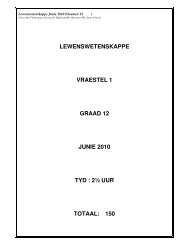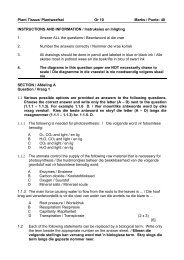CONTROL TEST 2
CONTROL TEST 2
CONTROL TEST 2
You also want an ePaper? Increase the reach of your titles
YUMPU automatically turns print PDFs into web optimized ePapers that Google loves.
GRADE 10 LIFE SCIENCES<br />
Photosynthesis and Respiration<br />
Fotosintese en Respirasie<br />
Total / Totaal: 60 marks Time / Tyd: 1 h<br />
INSTRUCTIONS AND INFORMATION<br />
Read the following instructions carefully before answering the questions.<br />
1. Answer ALL the questions / Beantwoord al die vrae<br />
2. Number the answers correctly / Nommer al die vrae korrek<br />
3. All drawings should be done in pencil and labeled in blue or<br />
black ink. / Alle sketse moet in potlood wees en die byskrifte in<br />
blou of swart ink.<br />
4. The diagrams in this question paper may NOT necessarily be<br />
drawn to scale. / Diagramme in die vraestel is nie noodwendig<br />
volgens skaal nie.<br />
Section / Afdeling A<br />
QUESTION / Vraag 1<br />
1.1 Various possible answers are provided as to the following<br />
questions. Choose the best answer and write only the letter (A –<br />
D) next to the question. For example 1.1.5 D. / Verskeie<br />
antwoorde word by elke vraag voorsien. Kies die beste antwoord<br />
en skryf slegs die letter (A – D) langs die vraag, bv. 1.1.5 D.<br />
1.1.1 Organisms that can produce their own food are … / Organismes wat<br />
hul eie kos kan produseer is ...<br />
A. heterotrophic / heterotrofies<br />
B. consumers / verbruikers<br />
C. autotrophic / outotrofies<br />
D. automatic / outomaties<br />
1.1.2 The following is needed for photosynthesis: / Die volgende word vir<br />
fotosintese benodig:<br />
A. O2, CO2 and light / en lig<br />
B. H2O, CO2 and light / en lig<br />
C. CO2 and light / en lig<br />
D. H2O and light / en lig
1.1.3 The stomata control the supply of the following raw material that is<br />
necessary for photosynthesis / Die huidmondjies beheer die<br />
beskikbaarheid van die volgende grondstof wat vir fotosintese<br />
benodig word:<br />
A. Enzymes / Ensieme<br />
B. Carbon dioxide / Koolstofdioksied<br />
C. Oxygen / Suurstof<br />
D. Mineral salts / Mineraal soute<br />
1.1.4 Air that has been exhaled contains…/ Lug wat uitgeasem word, bevat ..<br />
A. more carbon dioxide, less oxygen and a small quantity of water<br />
vapour. / meer koolstofdioksied, minder suurstof en 'n bietjie<br />
waterdamp<br />
B. more oxygen, less carbon dioxide and no water vapour. / meer<br />
suurstof, minder koolstofdioksied en geen waterdamp nie.<br />
C. more carbon dioxide, less oxygen and no water vapour. / meer<br />
koolstofdioksied, minder suurstof en geen waterdamp nie.<br />
D. the same amount of carbon dioxide, oxygen and water vapour. /<br />
Dieselfde hoeveelheid koolstofdioksied, suurstof en waterdamp.<br />
1.1.5 How many ATP molecules are formed during alcoholic fermentation<br />
from one glucose molecule? / Hoeveel ATP molekules word tydens<br />
alkoholiese fermentasie van een glukose molekule gevorm?<br />
A. 2<br />
B. 20<br />
C. 36<br />
D. 44 (2 x 5) (10)<br />
1.2 Each of the following statements can be replaced by a biological<br />
term. Write only the term next to the appropriate number. / Elkeen<br />
van die volgende stellings kan vervang word deur 'n biologiese<br />
term. Skryf die korrekte term neer langs die gepaste<br />
vraagnommer.
1.2.1 The green pigment in plants. / Die groen pigment in plante.<br />
1.2.2. The transparent type of tissue in a leaf that allows sunlight to<br />
penetrate.<br />
1.2.3. The form in which plants save glucose. / Die vorm waarin plante<br />
glukose stoor.<br />
1.2.4 The process that takes place in the mitochondria that produce 2 ATP<br />
molecules and CO2. / Die proses wat in die mitochondria plaasvind<br />
waartydens 2 ATP molukes en CO2 gevorm word.<br />
1.2.5 The respiration that takes place in yeast cells. / Die fermentasie wat in<br />
gisselle plaasvind.<br />
(1 x 5)<br />
(5)<br />
1.3 Choose an item from COLUMN A that matches a description in<br />
COLUMN B. Write only the letter (A – P) next to the question<br />
number<br />
(1.3.1 –1.3.10), for example 1.3.6 J.<br />
COLUMN A COLUMN B<br />
1.3.1 Cuticle A – Stiffness in muscles / Stywe spiere<br />
1.3.2 Light dependent B – Formed during a type of respiration /<br />
phase<br />
Gevorm tydens 'n tipe respirasie<br />
1.3.3 NAD C – Liquid content of a chloroplast.<br />
1.3.4 Iodine / Jodium D – Transparent / Deurskynend<br />
1.3.5 O2 shortage / O2<br />
tekort<br />
E – Takes place in the grana of the chloroplast.<br />
F – Used in test for starch / Gebruikj in die<br />
stysel toets<br />
G – Takes place outside the chloroplast.<br />
(1 x 5) (5)<br />
[20]
SECTION / Afdeling B<br />
QUESTION / Vraag 2<br />
An investigation was conducted to show the effects of increasing light<br />
intensity on the rate of photosynthesis of a plant. The plant was tested in two<br />
situations with two different concentrations of carbon dioxide. The results are<br />
recorded in the table below. / 'n Ondersoek was gedoen om die effek van<br />
toenemende ligintensiteit op die fotosintese tempo van 'n plant te ondersoek.<br />
Die plant was getoets in twee situasies met verskillende konsetrasies CO2.<br />
Die tabel gee die resultate.<br />
Light Intensity /<br />
Ligintensiteit<br />
(arbitrêre eenhede)<br />
(arbitrary units)<br />
Production rate of carbohydrates<br />
during photosynthesis / Produksie<br />
tempo van koolhidraat vorming<br />
tydens fotosintese (mg.hour -1 )<br />
In 0,05% CO2 In 0,15% CO2<br />
1 0,9 1,5<br />
2 1,5 2,3<br />
3 2,0 3,1<br />
4 2,3 3,9<br />
5 2,4 4,3<br />
6 2,4 4,3<br />
7 2,4 4,3<br />
2.1 Construct a line-graph of the production rate of carbohydrates<br />
(mg.hour -1 ), plotting both lines (in 0,05% and 0,15% CO2) on the same set of<br />
axes. / Teken 'n lyngrafiek van die produksie tempo van die koolhidrate<br />
(mg.uur -1 ). Teken beide lyne (in 0,05% and 0,15% CO2) op een assestelsel.<br />
(5)<br />
2.2 At what light intensity does the plant reach its maximum rate of<br />
photosynthesis? / By watter ligintensiteit bereik die plant sy maksimum<br />
fotosintese tempo? (1)<br />
2.3 At what light intensity was the production rate at it’s lowest? / By watter<br />
ligintensiteit was die produksie die laagste? (1)<br />
2.4 The rate of carbohydrate production, in both concentrations of CO2<br />
(0,05% and 0,15%) remained constant at light intensities of 5, 6 and 7<br />
arbitrary units. Suggest ONE possible explanation for this phenomenon. /<br />
Gee een moontlike rede waarom die koolhidraat produksie in biede CO2<br />
konsentrasies konstant gebly het by ligintensiteite 5, 6, en 7.(2)<br />
2.5 What is the advantage to a plant of a higher carbon dioxide<br />
concentration? / Wat is die voordeel vir die plant van 'n hoër<br />
koolstofdioksied konsentrasie? (2)
2.6 Food shortages are a major problem in many parts of the world today.<br />
How can the above experimental information be applied in practice, as<br />
a solution to the problem of food shortages? / Voedsel tekorte is<br />
globaal 'n groot probleem. Hoe kan die bogenoemde eksperiment se<br />
resultate en inligting toegepas word in die praktyk as 'n oplossing vir<br />
hierdie voedsel tekorte? (2)<br />
2.7 List the independent and the dependent variables for this experiment. /<br />
Gee die onafhanklike en die afhanklike veranderlikes vir hierdie<br />
eksperiment. (2)<br />
QUESTION 3<br />
3.1 Study the following diagram and answer the following questions. /<br />
Bestudeer die volgende diagram en beantwoord die volgende vrae.<br />
B<br />
E F<br />
3.1.1 Give the labels A to E / Gee A tot E se byskrifte. (5)<br />
3.1.2 Supply 4 adaptations of leafs (visible in the diagram) that helps with<br />
photosynthesis. / Gee 4 aanpassings (wysigings) van 'n blaar (sigbaar<br />
in die diagram) wat fotosintese bevorder. (4)<br />
3.2 Which part of the leaf ….... ? / Watter deel van die blaar …..... ?<br />
3.2.1 Contains the most chloroplasts. / Bevat die meeste chloroplaste?<br />
3.2.2 Is important for gaseous exchange? / Is belangrik vir gaswisseling?<br />
3.2.3 Transports carbohydrates? / Vervoer koohidrate? (3)<br />
[12]<br />
C<br />
A<br />
D<br />
[15]
Question / Vraag 4<br />
B<br />
C<br />
A<br />
4.1 What process takes place at A? / Watter proses vind by A plaas?<br />
(1)<br />
4.2 Name two products are formed during the process at indicated as C? /<br />
Noem twee wat gevorm word in die proses wat as C aangedui word?<br />
(2)<br />
4.3 Where does processes B and C take place respectively? / Waar vind<br />
prosesse B en C onderskeidelik plaas? (2)<br />
4.4 What is the name of the complete process represented by the diagram<br />
above? / Wat is die naam vir die volledige proses wat deur die<br />
bostaande diagram uitgebeeld word? (1)<br />
4.5.1 What step(s) in this overall process will not take place if there is no<br />
oxygen available? / Watter stap(pe) in die algehele proses sal nie<br />
plassvind as daar nie suurstof is nie? (2)<br />
4.5.2 What process will replace these missing step(s) in mammals? / Watter<br />
proses sal die vermiste stap(pe) vervang in soogdiere? (1)<br />
D<br />
E
4.5.3 What product is then formed that causes stiffness? / Watter produk,<br />
wat styfheid veroorsaak, word dan gevorm? (1)<br />
4.6 Give three reasons why one can say that the process represented<br />
by the diagram above is the opposite of photosynthesis. / Gee drie<br />
redes waarom 'n mens kan sê dat die proses wat deur die<br />
bostaande diagram uitgebeeld word die teenoorgestelde is van<br />
fotosintese. (3)<br />
[13]<br />
TOTAL 60 MARKS
Question 1.1<br />
1.1.1 C√<br />
1.1.2 B√<br />
1.1.3 B√<br />
1.1.4 A√<br />
1.1.5 A√<br />
Question 1.2<br />
1.2.1 chlorofil√<br />
1.2.2 Epidermal√<br />
1.2.3 stysel√<br />
1.2.4 Crebs cycle√<br />
1.2.5 alcoholic√<br />
Question 1.3<br />
1.3.1 D√<br />
1.3.2 E√<br />
1.3.3 B√<br />
1.3.4 F√<br />
1.3.5 A√<br />
(2 X 5 = 10)<br />
(1 X 5 = 5)<br />
<strong>CONTROL</strong> <strong>TEST</strong> 2<br />
GRADE 10<br />
Total: 60 marks<br />
Time: 1 Hour<br />
MEMO<br />
(1 X 15 = 10)<br />
[20]
SECTION B<br />
Question 2<br />
2.1<br />
√ Heading in capitals containing both variables.<br />
√ X-axis correct label and unit.<br />
√ Y-axis correct label and unit.<br />
√ Correct plotting of data lines.<br />
√ Legend (key) correct or label each line.<br />
2.2 At a light intensity of 5 (arbitrary units). √ (1)<br />
2.3 At a light intensity of 1 (arbitrary units). √ (1)<br />
2.4 The optimal level for photosynthesis had been reached. √<br />
Further increases in light intensity no longer increase the rate of<br />
photosynthesis. √ (2)<br />
2.5 It results in an increase in rate of photosynthesis√ and therefore<br />
increases the rate and quantity of carbohydrates (food) made. √<br />
(2)<br />
2.6 By growing plants in the correct CO2 concentration, optimal<br />
photosynthesis levels will result in the best crop yields. √<br />
Thus, an artificial environment (greenhouse) with greater CO2<br />
concentrations will results in greater crop yields. √ (2)<br />
2.7 independent: light intensity√<br />
dependent: rate of carbohydrate production. √ (2)<br />
[15]<br />
3.1.1 A = palisade B = chloroplast C = cuticle<br />
D = mesophyl E = stoma (5)<br />
(5)
3.1.2 flat / stoma on bottom of leaf / arrangement of palisade / many<br />
chloroplasts in palisade / air spaces etc. (any 4) (4)<br />
3.2.1 palisade<br />
3.2.2 stoma<br />
3.2.3 phloem (3)<br />
4.1 Glycolysis (1)<br />
4.2 ATP and water (2)<br />
4.3 Both in mitochondria (2)<br />
4.4 cellular respiration (1)<br />
4.5.1 B and C (2)<br />
4.5.2 anaerobic respiration (1)<br />
4.5.3 lactic acid (1)<br />
4.6 Uses oxygen while photosynthesis produces oxygen<br />
gives off carbon dioxide while photosynthesis gives off oxygen<br />
make energy available while photosynthesis bonds energy<br />
uses carbohydrates while photosynthesis produces carbohydrates<br />
etc. any 3 (3)<br />
TOTAL 60 MARKS


